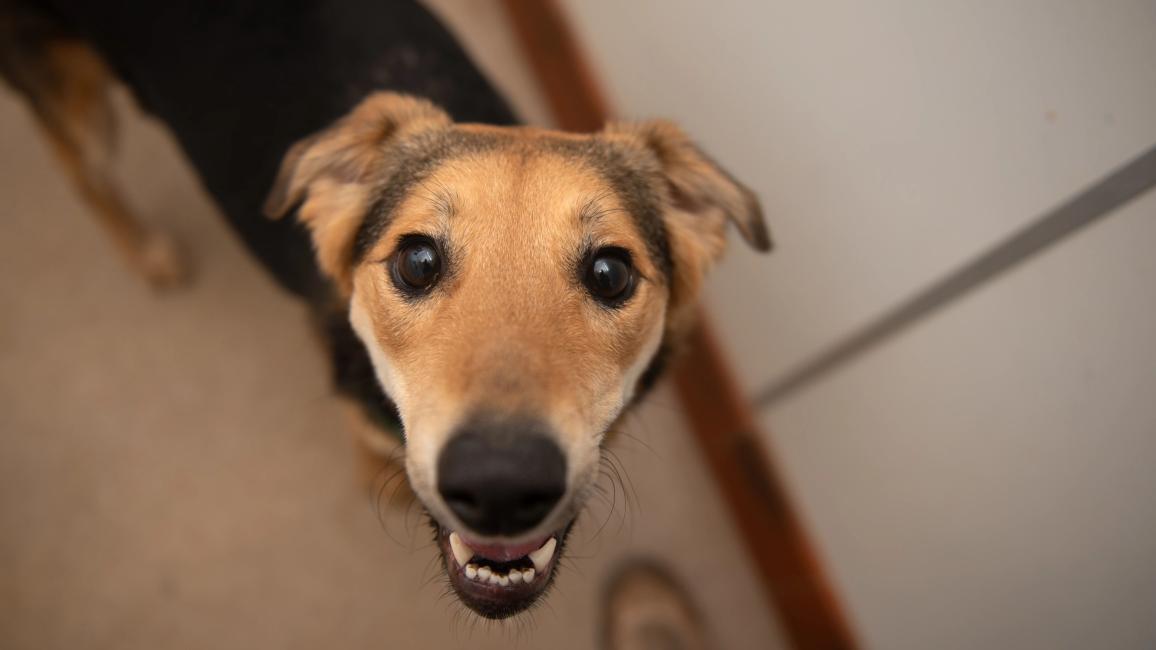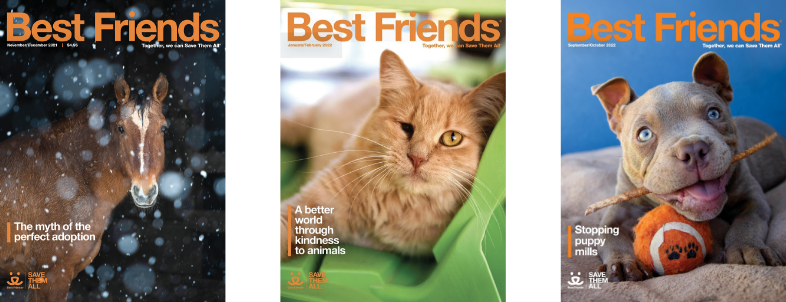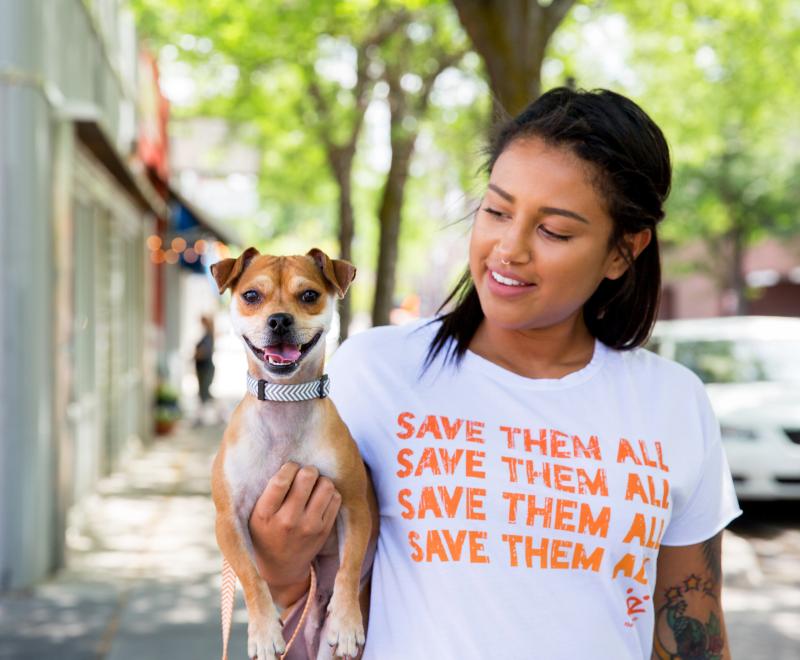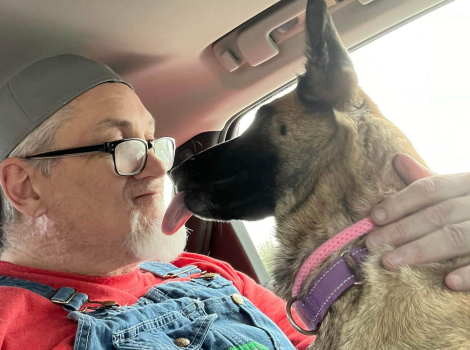Faces of No-Kill: Solutions for dog with special needs

They say you can’t have a rainbow without the rain, and that may hold true for Rainbow the dog, too. But if you ask her, the rain is just as exciting as the arc of colors that follows. After all, there are songs for singing and dancing in the rain, so it must be good. Rainbow, as her name suggests, is the kind of dog who can find joy in just about any situation.
This story is a part of our Faces of No-Kill series, highlighting the journey of pets who lost their place to call home. These pets are thriving today thanks to animal shelters that said yes to lifesaving with a community that found a way to save them. Best Friends’ goal is for every shelter and every community to reach no-kill, and this story shows why that’s so important.
That bright personality has seen Rainbow through a lot. Born with neurological issues, she landed at the Best Friends Pet Adoption Center in Los Angeles when her first family was unable to care for her. Only a few months old, she was having multiple seizures a day, and there was suspicion that her sight and hearing were impaired. The hustle and bustle of the city was also a bit overwhelming, and the added anxiety did not help her seizures.
To give Rainbow a quieter place to rest and the close medical care she required, the young pup was quickly transported to Best Friends Animal Sanctuary.

Settling down a puppy’s seizures
Arriving at the Sanctuary with a prescription for a seizure medication, Rainbow was given a few weeks to simply settle in. To keep things calm and predictable for the young pup in the hopes of lowering seizure activity, caregivers made sure her routine was as regular as possible. A curtain over her door kept any outside activity from disturbing her, and a camera in her room allowed caregivers to monitor her overnight behavior.
When she’d had some time to get a handle on life in her new home-between-homes, Sanctuary veterinary staff set up appointments for Rainbow with a neurologist and several specialists in Las Vegas. They prescribed additional seizure meds and supplements and even a special food for neurological health. Her condition and requirements would be ever-evolving, but now she had a solid foundation to grow from.
[Abandoned to loved: Sibling dogs with neurological issues find joy every day]
The quiet life suited Rainbow, and with her new prescriptions, the frequency of her seizures began to decrease, which meant the world started opening up. She started going to playgroups, where she happily body-slammed new dog friends all in good fun (her depth perception is a little questionable) and tumbled around like the puppy she was.
But while one of Rainbow’s medical concerns was coming under control and she was starting to enjoy everyday puppy things, another was getting ready to surprise her caregivers and veterinarians.

Pica for pebbles
“She wasn’t feeling well, and she wasn’t eating,” recalls Anabel Kirk, one of Rainbow’s caregivers. “She was having issues throwing up and having diarrhea — usually all signs of a blockage.”
X-rays showed something in Rainbow’s stomach, and it wasn’t moving through her. In an emergency surgery, veterinarians removed nearly 50 rocks that Rainbow had eaten. It turned out, in addition to her other neurological conditions, little Rainbow also had pica, an eating disorder that causes animals (including humans) to eat things usually not thought of as food. She didn’t have a taste for toys or blankets — some of the usual cravings for dogs with pica, but she’d been taking the chance every time she was outside to sneak some rocks into her mouth.
[Pica in Dogs: Causes, Diagnosis, Treatment]
Keeping Rainbow away from the outdoors — and all those readily available rocks — was out of the question, so caregivers had to find a way to keep the rocks out of her mouth while she was out and about. Muzzle training provided the most elegant solution; Rainbow would be able to go about puppy business as usual; she just wouldn’t be able to gobble up rocks. She was a bit more determined than her first snout accessory accounted for, however.
“There is a gap (in the front of the muzzle) that’s just a finger width, and she learned how to scoop rocks in through there,” says Joelle Winter, another of Rainbow’s caregivers. “So we duct-taped it, and then she learned how to scoop on the side.”
Clearly, the standard basket muzzle wasn’t enough to keep Rainbow from her favorite non-snack. A bright pink mesh muzzle that Anabel picked up — and then ironed rainbow patches onto — finally did the trick though. And Rainbow’s a good sport when it comes time to getting into all her walking gear.

A real focus on fun
These days, with her stomach full only of real food and tasty treats and her most recent seizure several months in the past, Rainbow’s entire focus is on having a good time. And she’s an expert at it.
“She’s such a goofball,” Anabel says. “She loves to play fetch, but she forgets where the ball is. You have to remind her that, ‘Hey Rainbow, you were running for the ball.’ She’s like Dory from Finding Nemo.” But every time that ball goes flying again, Rainbow is just as excited as the last to go chasing after it.
Being in the water is another very exciting experience for Rainbow — even if she’s not always expecting it. Because her depth perception is a bit off, sometimes when she’s going for a drink she bobs her entire head into her bucket, or when she’s at the dog park she stumbles her way into the pool. But far from being startled or put off, the moment she realizes she’s in the splashy stuff, Rainbow is having an absolute ball. She truly has a penchant for turning everything into the best thing she’s ever done.
“She’s one of those dogs who, when she’s out on a walk with a volunteer, she’ll stall for a minute and get the zoomies,” says Joelle. “She loves to prance; she’ll just jump and run around.”
Rainbow’s a play-hard, cuddle-harder kind of dog, and her tail doesn’t rest for a second from its wild wagging. She’ll always need a little extra TLC and a vigilant eye out for signs of seizures. But with that bright personality, it’s only a matter of time before a family falls in love with their own colorful Rainbow.

This article was originally published in the May/June 2024 issue of Best Friends magazine. Want more good news? Become a member and get stories like this six times a year.
Let's make every shelter and every community no-kill by 2025
Our goal at Best Friends is to support all animal shelters in the U.S. in reaching no-kill by 2025. No-kill means saving every dog and cat in a shelter who can be saved, accounting for community safety and good quality of life for pets.
Shelter staff can’t do it alone. Saving animals in shelters is everyone’s responsibility, and it takes support and participation from the community. No-kill is possible when we work together thoughtfully, honestly, and collaboratively.







